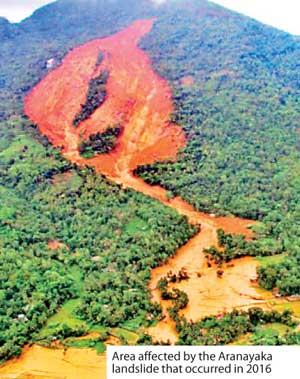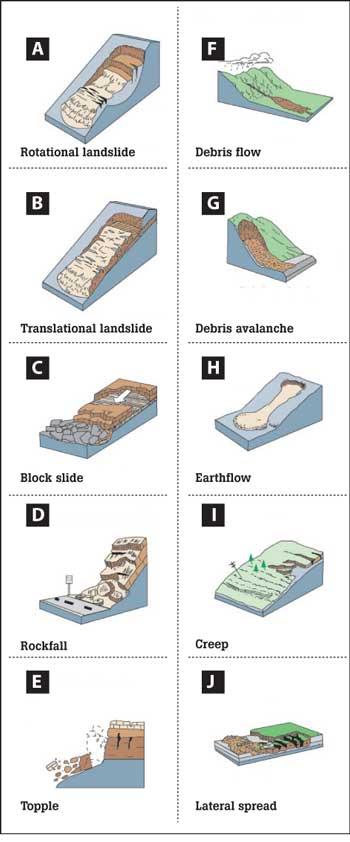11 May 2021 - {{hitsCtrl.values.hits}}
 Sri Lanka has been identified as a hotspot for landslides. The Meeriyabadda and Aranayaka landslides bear testimony to this statement. However, with thundershower warnings issued on a number of districts in the country, it is important to revisit landslide mitigation strategies, particularly in hilly areas. In some cases, latest technology has been used for water retention and increase soil strength. But engineering experts are now looking at possibilities of nature-based solutions to mitigate landslides. Speaking at the Moratuwa University’s Inaugural Lecture Series, Prof. Udeni Nawagamuwa of the Department of Civil Engineering, University of Moratuwa shed light on ‘Nature-based Landslide Mitigation’ with a few case studies done in several parts of the country.
Sri Lanka has been identified as a hotspot for landslides. The Meeriyabadda and Aranayaka landslides bear testimony to this statement. However, with thundershower warnings issued on a number of districts in the country, it is important to revisit landslide mitigation strategies, particularly in hilly areas. In some cases, latest technology has been used for water retention and increase soil strength. But engineering experts are now looking at possibilities of nature-based solutions to mitigate landslides. Speaking at the Moratuwa University’s Inaugural Lecture Series, Prof. Udeni Nawagamuwa of the Department of Civil Engineering, University of Moratuwa shed light on ‘Nature-based Landslide Mitigation’ with a few case studies done in several parts of the country.
 How landslides occur
How landslides occur
“A landslide is defined as the movement of a mass of rock, debris or earth down a slope,” he explained in his opening remarks.“Landslides are a type of ‘mass wasting’ which denotes any down-slope movement of soil and rock under the direct influence of gravity. As people move into new areas of hilly or mountainous terrain, it is important to understand the nature of their potential exposure to landslide hazards, and how cities, towns, and counties can plan for land use, engineering of new construction and infrastructure which will reduce the costs of living with landslides.”
Human activities could be a contributing factor in causing landslides. “However, many landslides caused by human activities could be avoided or mitigated. These could be a result of building roads and structures without adequate grading of slopes, poorly planned alteration of drainage patterns and disturbances caused to old landslides.”
Identifying warning signs
In most instances people are unaware of an impending landslide. But warning signs could be observed. Some of these include:
Mitigation measures
 Prof. Nawagamuwa then shed light on the latest Landslide Hazard Zonation Mapping Project (LHMP) implemented by the National Building Research Organisation. “Hazard zonation mapping is based on an extensive field study and evaluation of six causative factor attributes such as geology, slope, soil overburden, hydrology, landform and land use patterns in the area. While maps are available in 1:50,000 scale and 1:10,000 scale, 1:50,000 scale maps are available for Badulla, Nuwara Eliya, Kegalle, Ratnapura, Kandy, Matale, Kalutara, Galle, Matara and Moneragala districts. These maps display the distribution of the severity of landslide hazard potential in a given area.”
Prof. Nawagamuwa then shed light on the latest Landslide Hazard Zonation Mapping Project (LHMP) implemented by the National Building Research Organisation. “Hazard zonation mapping is based on an extensive field study and evaluation of six causative factor attributes such as geology, slope, soil overburden, hydrology, landform and land use patterns in the area. While maps are available in 1:50,000 scale and 1:10,000 scale, 1:50,000 scale maps are available for Badulla, Nuwara Eliya, Kegalle, Ratnapura, Kandy, Matale, Kalutara, Galle, Matara and Moneragala districts. These maps display the distribution of the severity of landslide hazard potential in a given area.”
Nature-based solutions
 “Landslide mitigation measures also include nature-based solutions which are interventions that make use of natural processes and ecosystem services to address hazards such as floods, erosion and landslides. The Sendai Framework for Disaster Risk Reduction (2015-2030) is one of the effective and sustainable techniques to reduce risk of disasters,” he added.
“Landslide mitigation measures also include nature-based solutions which are interventions that make use of natural processes and ecosystem services to address hazards such as floods, erosion and landslides. The Sendai Framework for Disaster Risk Reduction (2015-2030) is one of the effective and sustainable techniques to reduce risk of disasters,” he added.
“The role of plants in improving slope stability and minimising soil erosion can be divided into two categories; hydrological and mechanical mechanisms. However, both these mechanisms have positives and negatives. For example in the hydrological mechanism, foliage intercepts rainfall, causing adsorptive and evaporative losses that infiltrate precipitation to infiltrate. However, the depletion of soil moisture by root adsorption may encourage the soil to crack, thus increasing infiltration capacity. On the other hand, roots reinforce soil, increasing soil shear strength in the mechanical mechanism. But plants exposed to the wind could transmit dynamic forces to the hill.”
Prof. Nawagamuwa further said that some of the benefits of nature-based solutions in stabilising slopes include the greater ability to catch rainfall when there’s a high density of the canopy and leaf area. “This interception reduces and delays rainfall to the soil surface. A tree’s roots will increase soil shear strength via the tensile strength of its own roots and provide slope-shearing resistance during or after heavy rainfall on shallow landslides.”
Site-specific landslide risk assessment
“When choosing a site, all elements at risk including houses, buildings, infrastructure facilities, lifelines, topography, hydrology and ecological features, soil formations and socio-economic data related to populations likely to be exposed are being considered,” he explained.
But when selecting plants several aspects need to be looked into. “Architectural features and structure of plant root systems play a significant role in shallow slope stabilisation and erosion control. Ecological significant and compatibility with surrounding environment also needs to be considered. Native plant species are preferred because they tend to tolerate drought and need little irrigation, fertilisers, pest and disease control and demand less trimming. Prof. also emphasised on aboveground plant structure and belowground root system which stabilise slopes by intercepting and absorbing water, retaining soil, retarding run-off velocity, increasing surface roughness, rainwater interception and evapotranspiration.”
Speaking about natural vegetation types, he said that the dominant vegetation in the wet zone is tropical evergreen forests with tall trees, broad foliage and a dense undergrowth of vines and creepers. On the other hand, subtropical evergreen forests resembling those of temperate climates flourish in higher altitudes. Montane vegetation at highest altitudes tends to be stunted and windswept.
Recommended plant species
Grasses – Cymbopogon citrates– suitable for tropics and is known to be a good soil conditioner in worn out land. The plants quickly produce a bulk of organic material attracting worms and other beneficial creatures, quickly enriching the soil. The grass is useful for soil improvement and erosion control.
Small tree (Shrub) – Coffee arabica–suitable for tropics and subtropics. The plant firmly holds onto soil and is a wind barrier. Erosion control can be achieved by cultivating coffee with low spacing.
Medium size tree – Tremaorientalis– the plant can be found in secondary forests in the wet and intermediate zones. The tree has an extensive root system that enables to hold soil together and is categorised as a tree with high anchoring root index.
Large tree – Micheliachampaca– it is found in tropical and subtropical, moist broadleaf eco-regions. These are elevations of 200-1600 metres. These plants are known to hold soil tightly while acting as a wind barrier. The presence of roots increases the effective cohesion of soil, resulting in the increase of shear strength.
While drawing examples from a few case studies done in Sri Lanka Prof. Nawagamuwa said that certain challenges exist in applying nature-based solutions for landslide risk management in Sri Lanka. “Designers lack confidence in the use of vegetation for slope stabilisation, there’s a lack of knowledge about soil bioengineering and landscaping measures to stabilise unstable slopes and there’s limited interest in allocating resources for associated research, capacity building and knowledge enhancement of
landslide professionals.”
26 Nov 2024 26 Nov 2024
26 Nov 2024 26 Nov 2024
26 Nov 2024 26 Nov 2024
26 Nov 2024 26 Nov 2024
26 Nov 2024 26 Nov 2024